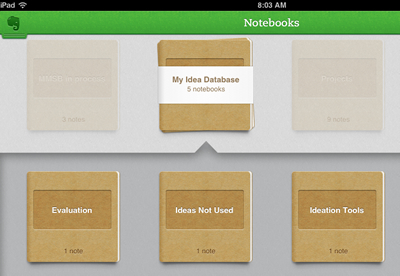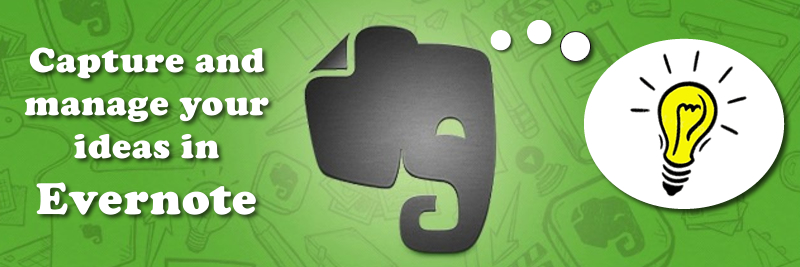Evernote, the popular cloud-based personal information management application, is an excellent tool for capturing, cultivating and managing your ideas. Here are some tips on how to do so.
Why Evernote is well-suited to idea management
First, let’s take a look at why Evernote is so well suited to serve as a simple personal idea management tool:
It’s cloud-based, with software and apps available for all popular computing platforms, including desktop (PC and Mac), mobile (Apple and Android) and web. Wherever you’re using it, your local copy of Evernote syncs to the cloud, so you always have access to the latest version your creative output.
You can capture ideas on demand, whenever they bubble up into your conscious mind, wherever you are.
It’s simple. There is no learning curve to get started with Evernote. You simply tap or click to create a new note and start typing. I even use an app called Dragon Dictate to speak my ideas into my iPhone. The app transcribes them, and I can then copy and paste the text of my idea into my repository in Evernote.
It can store just about any type of digital content quickly and easily. You can:
- Type text into a new note
- Dictate an audio clip directly into a note
- Use it to gather research and background information to support your idea
- Take pictures of signs, magazine pictures and more – raw materials and inspiration for your ideas. You can shoot pictures from within Evernote, or select an image from a folder on your phone, tablet or computer and easily add it to a note.
- Capture all or part of a web page, using a web clipper app for your favorite web browser – stimuli or background information for your creativity
- Send an e-mail containing information you need to a special Evernote address, which automatically inserts it into your default folder
- Use the web clipper to capture web pages or parts of web pages – make it part of your repository of stimuli
- Scan your handwritten notes and save them directly into Evernote as images. If your handwriting is fairly legible, the cloud-based application will even perform optical character recognition on your notes – part of its “capture anything” philosophy. You name it – if it’s in digital form, or can be put into it, you can save it in your Evernote database.
Setting up process and structure in Evernote
Evernote enables you to create folders in which to store your ideas. I’ve discovered that they are an essential tool not only to keep your ideas organized, but to provide important context regarding the status of each idea. For example, any ideas stored in an “evaluation” folder would be those that you have generated and cultivated, but not yet evaluated.
Evernote also enables you to tag documents within the application, to help you classify and find them easier.
I recommend that you set up folders for:
Inbox – This is your default folder, where you capture all incoming information on the fly. From there, it gets processed and moved to other folders.
Incubation – These are ideas you’re currently thinking about, gathering more research on or in the process of enhancing. You’re not done with these ideas yet. This is your “active ideas” folder where you’ll be spending most of your time.
 Evaluation – When you’re ready to evaluate your idea based on a set of criteria, move your ideas to this folder. You should also have at least one topic dedicated to a saved set of evaluation criteria, which you can copy and utilize whenever you need to evaluate a set of ideas.
Evaluation – When you’re ready to evaluate your idea based on a set of criteria, move your ideas to this folder. You should also have at least one topic dedicated to a saved set of evaluation criteria, which you can copy and utilize whenever you need to evaluate a set of ideas.
To Implement – Those ideas that performed best during the evaluation stage get moved to this folder, where you can add notes about what actions and resources will be needed to bring your top-notch ideas to fruition.
Ideas Not Used – These ideas may not be useful to you now, but may be useful in some other context at a future date. So use this folder to store all of the ideas you have decided not to implement.
Tools – Evernote is not only an awesome idea repository. You can also use it to store text-based idea techniques – questions, prompts and other catalysts designed to get you thinking creatively. A case in point: the popular SCAMPER technique, where each letter represents a way in which you can look at your challenge from a different perspective. Another example is the Phoenix Checklist, a valuable list of open-ended questions that you can use to think deeply about the problem or challenge for which you’re trying to brainstorm solutions. You can simply copy and paste the questions and keyword prompts into Evernote, or link out to the blog posts where they are referenced. Using either method, you now have a set of simple ideation techniques just a few clicks or taps away, wherever you go. Isn’t that powerful?
I recommend that you adopt a simple folder naming convention that is based upon the name of the project you’re working on and the step in the idea management process you’re at. For example, for ideas you’ve generated fir the ACME project, you would set up a holder named “ACME-incubation.”
If you upgrade your copy of Evernote to a premium version, you can share folders with others – ideal if you want to capture and evaluate ideas from a team, or collaborate remotely with others to develop an idea into a finished product or service.
Final steps
Once you have your tools and structure set up, then it’s time to start capturing ideas. In order to make this work, you must be dedicated to capturing and evaluating your ideas on a consistent basis. As your Evernote database grows in size, as mine has over the last several years, it can be hard to keep up with. I recommend you devote 15-30 minutes each morning to processing your ideas and inputs in Evernote. Make sure ideas end up in the right folder, and are properly titled and tagged to make them easier to find later.
Have an overall vision for how you will evaluate if Evernote is working well for you. Because I am a web publisher, I’m heavily focused on capturing ideas for content. My measurement of success is ensuring that my best ideas become “finished products” – articles, reports, infographics and other forms of content that are valued by my readers. Simply hoarding ideas isn’t enough. I must “ship” them into the world as finished pieces of knowledge and advice.
Seen in that context, Evernote is an invaluable creative partner – I couldn’t do what I do without it. This very article is being written in it, and my latest book, Up Your Impact: 52 Innovative Strategies to Add Value to Your Work, was birthed and developed almost completely within Evernote, using the techniques I’ve just described.
So why don’t you give Evernote a try? A basic account is free; if you want more storage space, you can purchase an upgraded package for only US$5 per month.


I really appreciate the info about SCAMPER and The Phoenix Checklist. I'm now re-engaging with Evernote!
Simple and elegant. I like it. Thanks Chuck.
Have been a fan of Evernote for some time & have adopted many of the recommendations from Chuck's book "Up Your Impact" including Folder creation.
Should you mislay an article that you've added to Evernote, the search facility is brilliant – you'll find it & quickly no matter how obscure the search term!
"Where did I leave those good ideas I had on some pieces of paper"? – is no longer a problem.
Wayne
[…] may also want to learn more about Evernote: How To use Evernote As A Powerful Tool and 7 Unusual Ways People Use […]
I use Evernote all the time both personally and professionally. This is a very good overview article. The hardest part about Evernote to me is finding a way to setup project and task management. I’ve tried most things out there, including GTD, but still not there yet. I liked your video on Trello – might be it.
IMO the worst thing in Evernote is the editor. I’ve tried the windows, mac and android versions and I think they all suck.